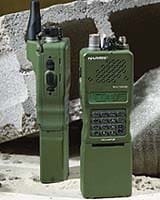Finally, we are beginning to see the development of the requisite mobile telecommunications infrastructure required to fully leverage commercial smart phones for military applications. You constantly read articles in the main stream media about how the military is going to adopt this phone or that phone. The problem is that, while they might work great in garrison where there is a well established backbone to facilitate their use, once you get to the field they become so many bricks; deadweight that is incapable of talking to one another let alone linking to the outside world. Now, companies like Harris Corporation are developing deployable 3G networks.
From the Harris press release:
Jointly developed by Harris and Battleground Telecommunications Systems (BTSâ„¢), KnightHawk 3G is a customizable cellular Network In a Box (NIB) compatible with commercial off-the-shelf (COTS) equipment, including smartphones and tablets. Each KnightHawk 3G is installed with BTS Praefectusâ„¢ Mission Management Software, which automates configuration and management of the cellular network, and enables each KnightHawk to operate autonomously or as a scalable network with hundreds of nodes for increased range. This compatibility allows users in the battlefield to leverage existing applications, thereby enabling them to track a team’s location, automatically translate foreign languages, and conduct remote training using existing advanced programs.
KnightHawk 3G features UMTS High Speed Packet Access, providing extremely fast connectivity of 14.4 mbps for downloads and up to 5.76 mbps for uploads. It also offers the benefits of small size, weight and power (SWaP), making it ideal for mobile, multi-mission requirements in challenging environments.
My biggest concern is that the system includes phone and tablets. This is kind of like having to purchase your phone from AT&T to use it on their network. Open architecture would be much better. On the plus side, a data network is drastically needed to leverage the Soldier-as-a-sensor concept. The idea is simple. Look at every Soldier deployed as a multimode sensor. He carries a variety of devices that could constantly be collecting data which is of interest simply because of where he is located. Now, if we could provide a data bus on the Soldier and his weapon and network all of his sensor heads, process the data on him to send back the tasty bits so as not to clog up the network with spam and then take all of that data and process it and then feed it back to the Soldier as a usable product we are on to something. The networks haven’t really exited to do this. Now that they are emerging, the difficult work of expanding the TPED capacity begins.

















































































































